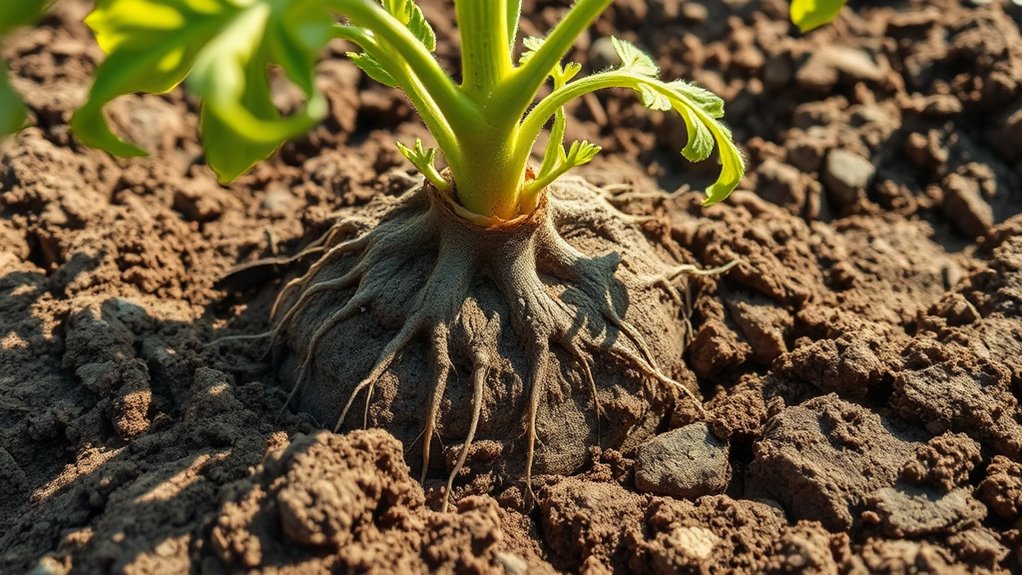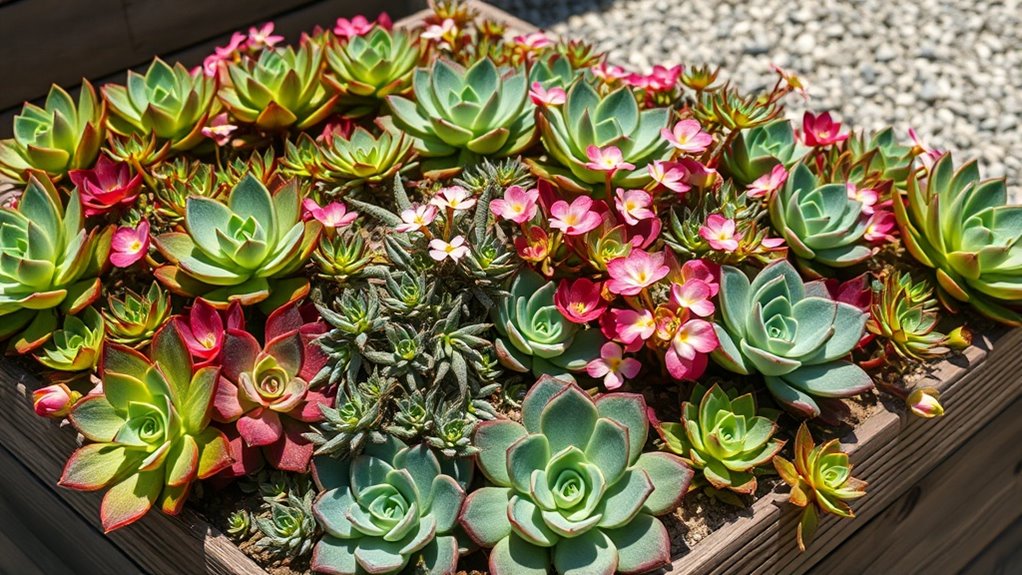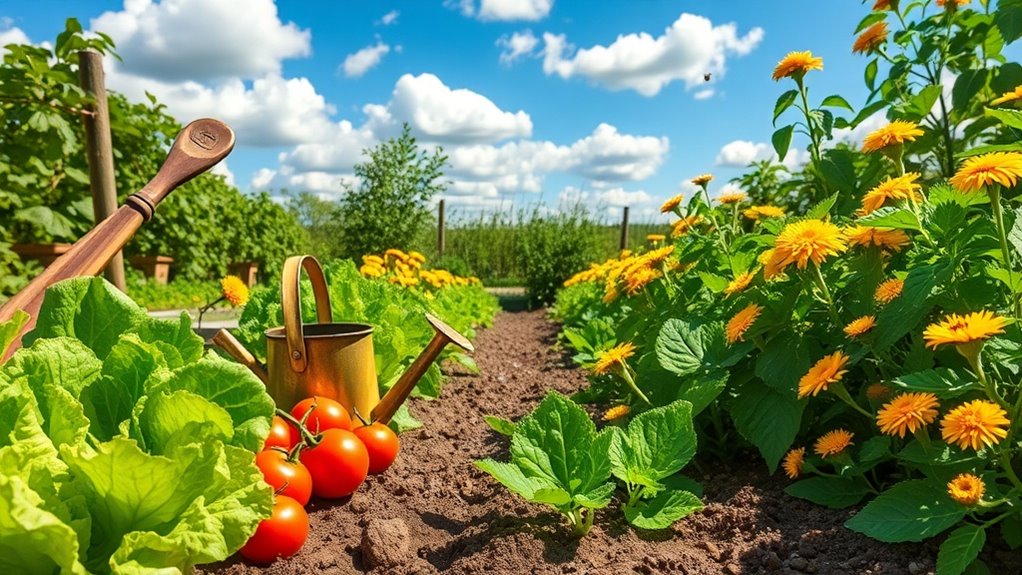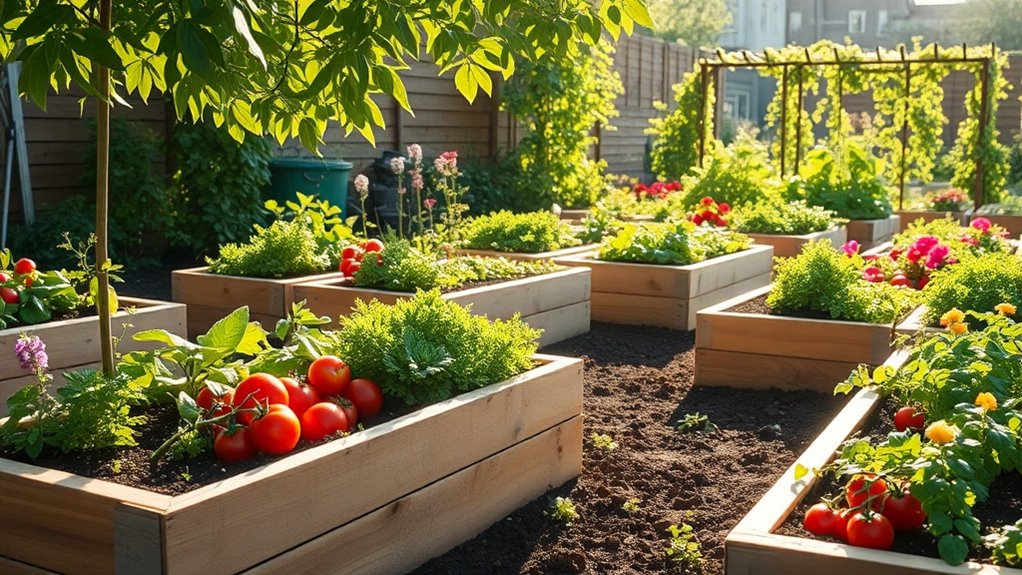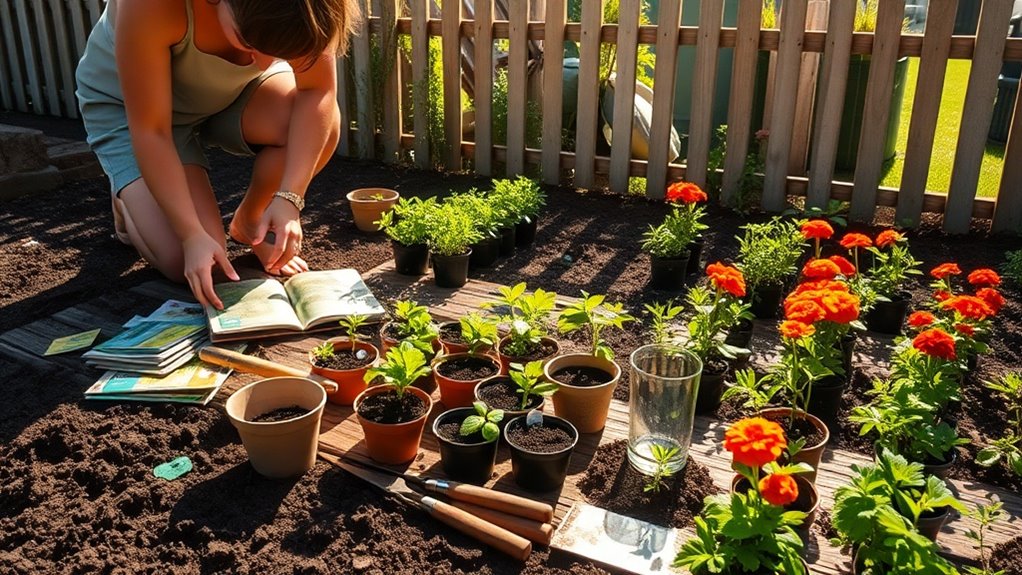The Soil Mistake I Made for Years – Don’t Repeat It!
For years, you’ve overlooked soil testing, letting pH imbalances and nutrient deficiencies wreak havoc on your garden’s yields and plant health. This costly error stunts growth, invites pests, and wastes resources by hindering nutrient uptake and root development. Don’t repeat it—begin with simple tests to pinpoint issues and boost productivity. Further insights await to guide you toward thriving soil and abundant harvests.
Key Takeaways
- Don’t skip regular soil pH testing; it leads to nutrient imbalances and stunted plant growth.
- Avoid neglecting soil compaction; it restricts root development and water absorption.
- Always use proper sampling techniques to ensure accurate soil test results.
- Incorporate organic matter like compost to prevent soil nutrient depletion over time.
- Monitor soil health routinely to avoid long-term damage from poor quality and imbalances.
The Soil Mistake I Kept Making
While you’ve likely encountered soil issues yourself, the mistake I kept making was neglecting to test pH levels before planting, which often led to nutrient imbalances and stunted growth. Embracing soil testing as a proactive measure can help avoid these pitfalls and enhance overall gardening outcomes.
In soil prep lessons, you learn that accurate pH testing is foundational for effective soil preparation. You start by selecting a reliable test kit, collecting representative soil samples, and analyzing results promptly.
Based on findings, you actively amend the soil—adding lime to raise pH or sulfur to lower it—ensuring optimal conditions.
These soil prep lessons teach you to prioritize testing, preventing common errors and promoting better plant establishment through precise interventions.
Additionally, regular soil testing can significantly increase crop yields by optimizing nutrient availability and plant health.
Why Poor Soil Quality Affects Your Garden
Poor soil quality undermines your garden’s productivity by disrupting nutrient availability and root health, leading to weaker plants and lower yields.
You’ll notice plants struggle as compacted soil restricts root penetration, limiting water absorption and oxygen exchange, which stunts growth.
Imbalanced pH levels hinder nutrient uptake, causing deficiencies that manifest as yellowing leaves or poor fruiting.
Pests and diseases thrive in stressed environments, exacerbating damage.
Ultimately, you’re left with diminished harvests and increased maintenance, as subpar soil forces plants to expend energy on survival rather than thriving.
Prioritize soil health to maximize your garden’s potential. Fortunately, you can enhance your soil using no-cost methods with materials right from your backyard.
By mastering soil preparation techniques, you can ensure your plants thrive in any environment through essential steps like proper aeration and nutrient balancing.
How to Test Soil for Nutrient Levels
You gather soil samples from various spots in your garden to ensure a representative mix.
Next, you analyze these samples using a reliable soil test kit or lab service to measure key nutrient levels like nitrogen, phosphorus, and potassium.
Understanding these results lets you make informed adjustments and prevent nutrient-related errors. By decoding soil signs, you can also identify additional factors affecting soil health and fertility.
For instance, testing your soil can reveal why store-bought soil mixes may fall short in providing optimal nutrients for your plants.
Gather Soil Samples
Gathering soil samples is essential for accurately testing nutrient levels, so start by selecting areas that represent your garden or field. You’ll identify variations in soil texture, pH, and drainage to ensure representative sampling. Use clean tools to avoid contamination; aim for 10-15 samples per area, taken from 6-8 inches deep.
| Tool | Purpose |
|---|---|
| Soil Auger | Extracts core samples |
| Hand Trowel | Gathers surface soil |
| Soil Probe | Checks deeper layers |
Mix samples thoroughly in a clean bucket, label them by location, and store in sealed bags for accurate results. This method minimizes errors and enhances reliability.
Analyze Nutrient Levels
Several methods enable you to test soil nutrient levels accurately and efficiently.
You’ll use these to identify deficiencies in key elements like nitrogen, phosphorus, and potassium, preventing the mistakes that stunted my plants for years.
Choose based on your resources and precision needs.
-
Home test kits: Provide rapid results for pH and major nutrients; interpret colors against included charts for immediate adjustments.
-
Laboratory analysis: Send samples for comprehensive reports on micronutrients and soil health; it’s precise but requires waiting.
-
Digital probes: Insert electronic meters to measure pH and conductivity in real-time; calibrate regularly for accuracy.
-
Field test strips: Dip strips into soil extracts for quick nutrient detection; they’re portable for on-site decisions.
-
Professional consultations: Combine tests with expert advice to correlate results with plant needs, ensuring balanced fertilization.
Common Signs of Unhealthy Garden Soil
You notice yellowing leaves on your plants, which often signal nutrient deficiencies in your garden soil. Many gardeners fall for common soil myths that can lead to overlooked soil health problems.
Soil compaction creates a hard layer that restricts root growth and water infiltration.
Identifying these signs early lets you address soil health issues effectively.
By learning from soil prep mistakes, you can improve your garden’s overall productivity and health.
Yellowing Leaves
Yellowing leaves often indicate nutrient deficiencies in garden soil, such as a lack of nitrogen or iron, which hinder chlorophyll production and leave plants vulnerable to further stress.
You must assess your soil’s pH and nutrient levels promptly to address these issues before they escalate.
-
Monitor leaf patterns: Yellowing between veins signals iron shortage, helping you pinpoint specific deficiencies.
-
Test soil regularly: Use kits to detect low nitrogen, ensuring you’re not overlooking critical imbalances.
-
Observe plant vigor: Wilting alongside yellowing shows nutrient stress, urging immediate action on your end.
-
Adjust feeding routines: Apply balanced fertilizers to restore essential elements, preventing long-term damage.
-
Track environmental factors: Excessive water or poor drainage exacerbates deficiencies, so evaluate your garden’s conditions carefully.
Soil Compaction
Soil compaction occurs when soil particles are densely packed, limiting root penetration and water movement, which often manifests as hardened surfaces and stunted plant growth in your garden.
You’ll notice water pooling on the surface instead of absorbing, indicating poor drainage and reduced aeration. Plants may show wilting despite adequate watering, as roots struggle for oxygen and nutrients.
Check for difficulty inserting a garden tool into the soil; if it’s tough, compaction is likely.
Regularly aerate your soil to prevent this issue, ensuring healthier root systems and vibrant growth for your plants.
Choosing the Right Soil Amendments
Amendments play a key role in correcting soil deficiencies and boosting fertility. You assess your soil’s needs first, selecting amendments that target specific issues like nutrient imbalances or poor structure, ensuring optimal plant growth without overcorrecting. Additionally, incorporating sustainable practices can help align your soil amendments with eco-friendly gardening methods for long-term benefits.
-
Test soil pH and nutrients: Use kits to identify deficiencies, guiding you toward lime for acidity or phosphorus for blooms.
-
Incorporate organic matter: Add compost to improve microbial activity and water retention in sandy soils.
-
Balance with minerals: Apply gypsum to break up clay, enhancing drainage and root penetration.
-
Consider slow-release options: Opt for bone meal for gradual nitrogen, sustaining long-term fertility.
-
Evaluate environmental impact: Choose sustainable amendments like biochar to sequester carbon and minimize runoff.
By adopting natural soil preparation techniques, you can significantly enhance your harvest without relying on fertilizers, promoting healthier plants and increased yield.
My Journey to Fixing Soil Problems
After years of struggling with nutrient-poor soil that hindered my garden’s growth, I’ve learned that targeted interventions can transform even the toughest patches. Moreover, by utilizing kitchen scraps in your composting process, you can produce nutrient-rich material to further improve soil quality.
You start by testing your soil’s pH and nutrient levels to identify precise deficiencies, guiding your correction efforts.
Then, apply suitable amendments like compost to enhance organic content or adjust pH for better nutrient uptake.
Continuously monitor changes through regular soil analysis and plant performance metrics, making data-driven adjustments.
This systematic approach builds soil health over time, helping you avoid common pitfalls and achieve sustained productivity in your garden.
Additionally, incorporating organic composting with kitchen scraps and garden waste can further boost soil fertility and support sustainable practices.
Essential Tools for Soil Preparation
As you prepare your soil, you’ll rely on hand tools essentials like spades and forks for accurate digging and weeding.
Next, you’ll select tilling equipment basics, such as rototillers, to break up compacted earth efficiently.
Finally, you’ll choose aeration device options, including core aerators, to improve soil structure and root health.
Hand Tools Essentials
When preparing soil, you’ll rely on several essential hand tools to avoid common mistakes and ensure effective results. These tools enable precise manipulation, reducing errors like uneven beds or compaction that hinder plant growth.
-
Spade: Use a sharp, ergonomic spade to cut cleanly through soil, minimizing effort and preventing back strain while maintaining soil structure.
-
Garden Fork: Leverage a sturdy fork to loosen compacted earth without over-tilling, enhancing aeration and root penetration for healthier ecosystems.
-
Bow Rake: Employ a wide-toothed rake to level surfaces accurately, ensuring uniform seed contact and optimal moisture retention.
-
Hoe: Select a sharp hoe to disrupt weed roots efficiently, preserving nutrient balance and fostering sustainable soil health.
-
Hand Trowel: Choose a durable trowel for precise digging of planting holes, allowing targeted amendments and reducing unnecessary disturbance.
Tilling Equipment Basics
Tilling equipment drives efficient soil preparation, helping you break up and aerate ground for optimal plant growth.
You’ll need a reliable tiller, such as a rotary model, which uses powered tines to loosen compacted soil quickly. Select based on garden size: front-tine tillers offer control for small spaces, while rear-tine versions handle larger areas with ease.
Ensure your equipment has adjustable depth settings for precise work and sturdy construction to withstand repeated use. Regular checks on blades and belts keep it performing efficiently, avoiding common errors that lead to poor soil conditions.
Aeration Device Options
Aeration devices enhance soil health by introducing air and reducing compaction, building on your tilling work.
You’ll explore options that penetrate soil layers efficiently, from manual to motorized tools, ensuring optimal oxygen flow for root growth and nutrient uptake.
-
Spike aerators puncture soil to relieve compaction, ideal for clay-heavy ground where you need fast, surface-level relief without removing material.
-
Core aerators extract soil plugs, allowing deeper water and air penetration; use them for compacted lawns to foster microbial activity and drainage.
-
Manual forks provide precise control for small gardens, letting you target specific areas while building soil structure through physical effort.
-
Powered drum aerators cover large areas quickly with rotating tines, helping you maintain even aeration and prevent future compaction.
-
Liquid aerators break up soil chemically, offering a non-invasive option when you’re dealing with sensitive root systems or hard-to-reach spots.
Avoiding Over-Fertilization in Soil
While over-fertilization might seem like a quick fix for nutrient deficiencies, you’ll actually harm your soil by disrupting its natural balance and promoting nutrient runoff.
Instead, conduct regular soil tests to gauge exact nutrient levels, preventing excess application that causes salt buildup and root damage.
You’ll inhibit beneficial microbial activity, leading to poor plant health and increased erosion risks.
By applying fertilizers judiciously—based on precise calculations—you maintain optimal pH and nutrient ratios, fostering a resilient soil structure without unnecessary chemical overload.
Best Practices for Soil Drainage
Effective soil drainage ensures your plants thrive by preventing water accumulation that leads to root rot and nutrient leaching.
To achieve optimal drainage, you’ll assess and modify your soil structure for better water flow, minimizing risks like compaction and poor aeration.
- Conduct percolation tests to measure water infiltration rates accurately.
- Incorporate coarse amendments, such as sand or perlite, to boost soil porosity.
- Grade your garden slopes to channel excess water away from roots.
- Install French drains or tiles in saturated zones for efficient runoff.
- Monitor soil moisture with tools like tensiometers to maintain balance.
Long-Term Strategies for Soil Health
To sustain your soil’s vitality after establishing good drainage, you’ll implement long-term strategies that emphasize nutrient balance and ecosystem resilience.
Begin with biannual soil testing to assess nutrient levels, pH, and organic matter, then apply precise amendments like compost or balanced fertilizers.
Adopt crop rotation to prevent depletion and disrupt pests, while integrating cover crops such as clover to boost structure and water retention.
Minimize tillage to protect microbial communities and reduce erosion.
Monitor for compaction and biodiversity, adjusting practices based on data.
These targeted approaches ensure sustained fertility, resilience against stresses, and long-term productivity.

